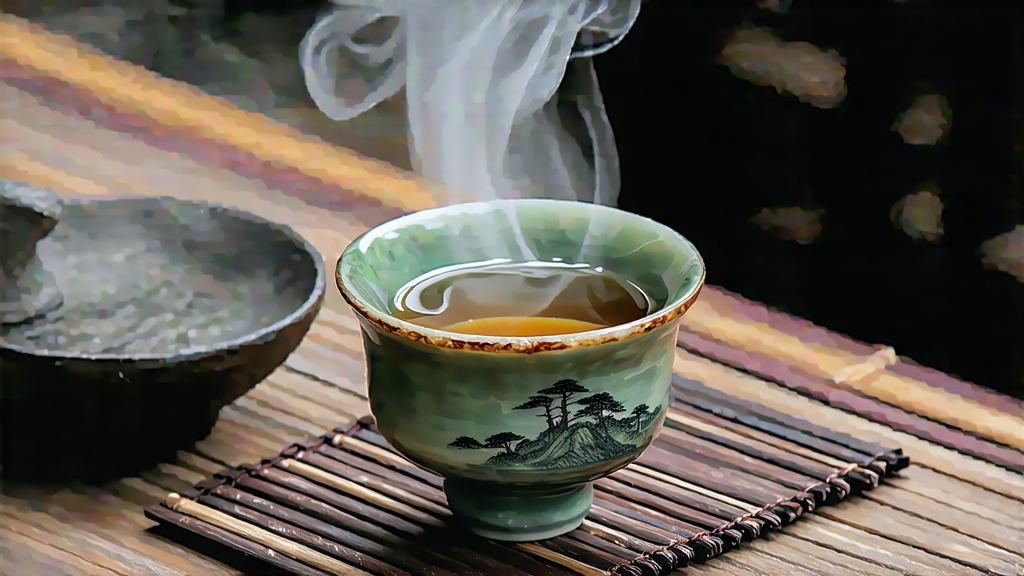
If green tea is China’s liquid jade and black tea its mahogany treasure, then Phoenix Dancong offers the Middle Kingdom’s most perfumed secret. Nestled in the mist-capped Phoenix (Fenghuang) Mountains of northeastern Guangdong, this oolong family captivates connoisseurs with fragrances that mimic peach blossom, gardenia, almond, ginger flower—even tropical lychee—while still delivering the mineral depth and lingering sweetness that define great rock oolongs. Unlike the blended aromatics of supermarket teas, each Dancong is the self-expression of a single ancient tree or a tightly defined clone, making every harvest a vintage worth chronicling.
Historical Roots
Local chronicles credit the Song imperial court (960-1279 CE) with first praising “Phoenix tribute tea,” yet villagers speak of an older, almost mythic origin. A 700-year-old Song cultivar still stands on Wudong Peak, its gnarled trunk wrapped in red silk by farmers who believe the tree houses the mountain spirit. During the Ming dynasty, monks from nearby Luyuan Temple refined the partial-oxidation technique that converts fresh leaf into oolong, and by the late Qing the tea had migrated down the Han River to Chaozhou’s mercantile port, where overseas Teochew traders carried it to Southeast Asia. There, in the shophouses of Bangkok and Singapore, the name “Dancong”—literally “single bush”—was formalized, distinguishing these micro-lot teas from bulk Wuyi oolongs arriving in the same junks.
Micro-terroir and Varietals
Phoenix Mountain rises abruptly from the subtropical plain, its granite spines catching monsoon clouds that drop 2,100 mm of rain annually. Elevation ranges from 350 m to 1,400 m, and every 100 m shift rewires temperature, humidity, and diurnal swing, yielding a patchwork of micro-terroirs. More than eighty aromatic profiles, or “fragrance types,” have been catalogued by the local Tea Research Institute, each tied to a specific village, slope, and tree age. Among the most celebrated are:
• Huangzhi Xiang (Gardenia Fragrance) – low-oxidation, pale gold liquor, bright top notes of white petals.
• Mi Lan Xiang (Honey-Orchid) – medium oxidation, amber cup, tropical fruit and longan sweetness.
• Zhi Lan Xiang (Magnolia) – heavy oxidation, copper infusion, creamy body with cool menthol finish.
• Tong Tian Xiang (Ginger Flower) – high-elevation, slow growth, peppery-spicy nose, mineral core.
• Ya Shi Xiang (Duck-Shit Aroma) – the deliberately vulgar name guards a precious, orchid-like bouquet; today the most sought-after by young aficionados.
Farmers further subdivide each fragrance type by mother tree. Thus “Old Bush Mi Lan” from Wudong at 1,100 m can fetch US $2,000 per 500 g, while the same cultivar grown at 600 m sells for one-tenth the price, illustrating how terroir trumps genetics in the cup.
Crafting the Fragrance
Dancong production follows the Chaozhou adage “one day becomes tea, three days become art.” Picking begins at dawn when dew still pearls the leaf; only the standard “half-open” three-leaf set is plucked. Sun-withering on bamboo trays lasts 20–30 minutes, just long enough to soften cell walls. Indoor withering follows, where leaf is alternately shaken and rested in 90-minute cycles that bruise edges and initiate oxidation. The master’s nose decides when the green grassy note has retreated and floral precursors dominate—usually after 6–8 cycles.
Oxidation is arrested by a 280 °C tumble in a mechanized drum, yet the critical “water removal” (shaqing) still demands hand judgment: leaves must squeak like silk when rubbed yet remain supple enough for the night-long rolling that shapes the twisted, dark dragonfly-wing strips. Charcoal baking finishes the tea, but here Dancong diverges from Wuyi rock oolongs. Instead of a single high-fire bake, the leaf undergoes three progressive roasts at 80 °C, 60 °C, and 45 °C across six weeks, each followed by a week of “resting” so that moisture migrates outward evenly. The result is a tea that is simultaneously fragrant and deeply roasted